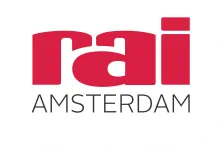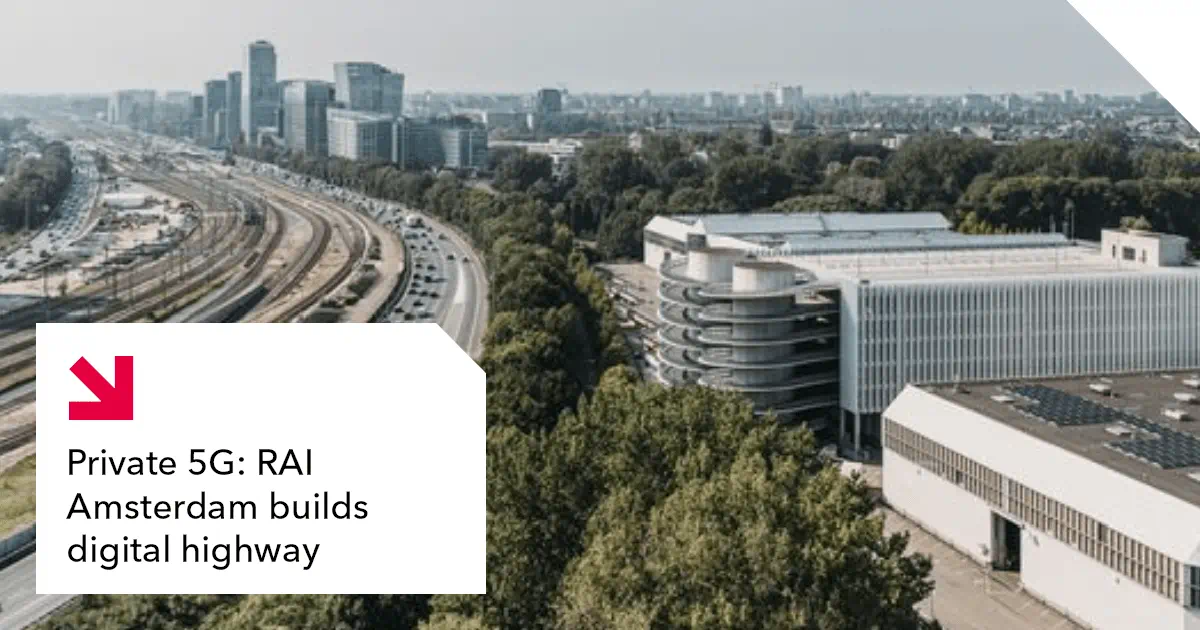The name may be slightly confusing… Don’t we already have 5G? The answer is clear, though: the 5G we all have on our mobile phones is much less advanced than the private 5G network that RAI Amsterdam has recently installed on its premises. This provides super-fast internet, without delays, even when large amounts of users and data are involved. It can also be set up uniquely for every user, creating a wealth of applications including for drones, livestreams, self-driving vehicles and robots. All in all, private 5G makes our convention centre an even better host for innovations.
Bret Baas is Director of IT & Digital at RAI Amsterdam while Paul Hassink is Product Manager IT and advises organisers on how to use IT during their event. In this article they explain why private 5G is so revolutionary and the opportunities that it brings. Bret: “We have built a digital highway. Now bring on the innovators.”
RAI Amsterdam as a hub of innovation
RAI Amsterdam is a place where people, technologies and ideas connect. Research shows that people mainly visit events to be inspired. “We are a hub of innovation,” says Bret. “Events like IBC, Cisco Live, Amsterdam Drone Week, Intertraffic and medical conferences are all about the latest technologies and applications. We are therefore constantly working to provide a digital infrastructure which facilitates the showcasing of these innovations. Private 5G has only been available in the Netherlands since January 2024 and we worked closely with Cisco and NTT Data Nederland to install it in RAI Amsterdam in just a few weeks. The network made its debut on 5 February during Cisco Live.”
Technology delivers
A brief technical summary will help clarify what makes private 5G so special. While various frequencies are reserved for 5G, only the low frequency (up to 700 MHz) was available until January. Phone companies purchased frequency packages to provide public 5G to their customers. Paul Hassink: “This is 4G on steroids, but it doesn’t provide any extra functionalities. The network still stagnates when lots of people use it at the same time, and it can come with minor delays in data traffic.”
The 5G frequency now available for private use is higher (3.4-3.8 GHz), giving a stronger and faster signal. The main difference is that there is less latency – fewer signal delays. The latency is so low, in fact, that data over 5G is received in real time. This has enormous benefits for the likes of self-driving cars where a latency of even a millisecond could be the difference between life and death. It is this new and faster version of 5G that is now available in RAI Amsterdam.
From drone to robot arm
New possibilities arise with latency out of the picture, especially for exhibitors “Drones, robots, livestreams – these are all applications for which reliability and low latency are vital,” says Paul. “When holding a drone race in the past using a strong Wi-Fi signal we had to switch off all other Wi-Fi networks to prevent interference. This is much easier now. Every drone is equipped with an embedded sim called 5G eSIM, which controls the device directly. As all drones are equipped this way, there is no interference or delays and they can fly extremely accurately at over 100 kilometres per hour.” Private 5G was also used during the coronation of King Charles in the UK when the real-time high-definition broadcast using scores of cameras had to be fully synchronised. All cameras were therefore equipped with a 5G eSIM, which could air huge amounts of data worldwide without any interference or delay.
Bret: “It generates possibilities that were inconceivable before. You can control a robot arm remotely, for example. Imagine a remote surgical operation – that is what private 5G enables. How cool would it be if this could be demonstrated at a medical conference? And then broadcast in high definition too?”
Secure and stable
In addition to the benefits of low latency and high speed, private 5G has other major advantages, Paul explains. “In the past we had to give exhibitors a cable in order to be certain of a super-reliable connection. These were quite expensive, had to be ordered in advance and offered only a limited range. This is now a thing of the past with private 5G. It can also easily be customised: we have the network in-house and can install every eSIM individually to cater for issues such as speed and security.”
Private 5G is also far more secure than a Wi-Fi connection,” Bret continues: “And I like the way it can handle lots of small data streams. This means devices can easily be linked, which in turn creates possibilities for a real internet-of-things. Finally, there is no longer any risk of overloading. No matter how many 5G devices are in place, all will work smoothly.”
Launch event
As one of the largest IT events worldwide, Cisco Live was the first to use the opportunities of private 5G in RAI Amsterdam in early February. The exhibitors were very enthusiastic about the possibilities, according to Paul. “They used real-time interactive videos, for instance, without needing cables. And that’s just a fraction of what’s possible. I expect the number of applications to increase with every event.”
Exhibitor input welcome
“We take our role as an innovation hub very seriously,” concludes Bret. “The infrastructure of private 5G provides for greater capacity on the network, more flexibility and safer connections that are truly real-time. We can only guess at the potential this generates, which is why we’re asking clients to consider the options and discuss them with us. What would you like to do? Cleaning robots that can communicate with each other? Have engineers carry out repairs remotely? Hold an interactive video session with 1,000 participants from around the world? Lots of devices working together to perform a single task? Whatever you have in mind we’re confident our data connections can handle it.”
Private 5G is currently available in Halls 1 and 5. Coverage will be further expanded over the RAI premises in the coming months. Contact Paul Hassink for more information.

